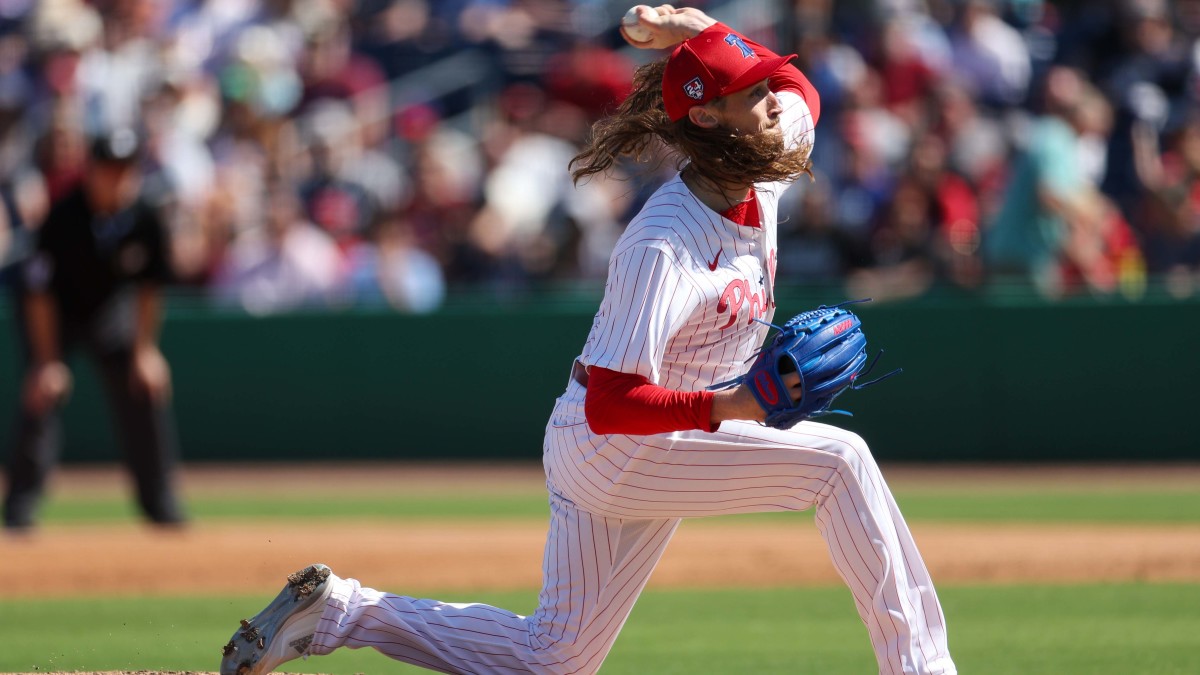MLB’s Uniform Fiasco Is About More Than See-Through Pants. It’s About Trust.

Let’s stipulate that the pants are the same.
Let’s take Major League Baseball’s word for it that this year’s much-maligned Nike-designed, Fanatics-produced uniform pants—the ones players call “see-through,” the ones they drag reporters to their lockers to feel, the ones they are trying to get away with not wearing—are the same as last year’s pants.
What does it say about the relationship between the league and the players that none of them seem to believe it?
“People are suspect right out of the gate,” says Philadelphia Phillies catcher Garrett Stubbs. “It’s like, ‘You’re lying.’ The perception is definitely there. And obviously the history is there, too.”
Every sports story is a labor story, and this one dates back to 1965 when the fledgling Major League Baseball Players Association began to strengthen in response to the owners’ threat that they would cancel the players’ pension plan. Since then the sport has seen nine work stoppages, some $270 million in owner fines after the players proved the teams colluded to suppress salaries in the ’80s and untold squabbles.
“I feel like we can tell them the sky is blue and they’d figure out a way to tell us it’s not,” says Phillies reliever Matt Strahm. He acknowledges that the contrary is also true: At this point, if the league told players the sky was blue, they’d look out the window and check for themselves.

MLB and Nike both said in statements that they would continue to work together and with the players to adjust the fit of the uniforms. Neither addressed the pants question directly, but people familiar with the process insist the fabric is the same as last year’s.
The players don’t buy it. “The problem is that lawyers and businessmen think us young athletes are stupid,” says Phillies right fielder Nick Castellanos. “So they just tell us whatever and they expect us to believe it, and that’s kind of unfortunate, because it’s not that we’re stupid. We just didn’t go to law school and don’t know how to negotiate business deals. That doesn’t mean that we’re not intelligent. We know when we’re being lied to. Just say straight up, ‘Listen, we wanted to save some money here. This is how much we’re saving with this quality of uniform. An old uniform and the old stitching cost us this much, and we’re saving this amount of money.’ And then our next conversation would be, ‘O.K., if you’re saving that much money, where are you putting it into the game?’”
As soon as players arrived at spring training in mid-February, they began complaining about the new uniforms. In 2020, Nike replaced Majestic as the league’s uniform provider. Fanatics, which bought Majestic in ’17, began producing the uniforms out of the same Majestic facility in Easton, Pa. Nike and MLB spent years designing the new jerseys, both entities have said, and debuted them this spring.
Initial reviews were terrible. First, players griped that the Nike Vapor Premier jerseys looked cheap. (Strahm points out that after three washes, his jersey has already begun to fray.) Then they got a look at the pants—and the public got a look at what lay beneath the pants. The harsh lighting and high pixel count of pictures taken on photo day showed pants sheer enough to cause some players to rethink their wardrobe. Black underwear has suddenly become a lot more popular.
Aside from the see-through fabric, the only obvious difference between last year’s pants and this year’s is the style of the belt loops, so Phillies reliever Jeff Hoffman says he plans to ask the clubhouse attendants to sew the new belt loops onto his old pants.
The league has said that the goal was to improve the jerseys’ feel and that it solicited feedback from players along the way. “We offered input—suggested what the challenges were going to be—and they needed to be remedied on the front end,” MLBPA executive director Tony Clark told reporters last week. “They weren’t.”
An MLB.com story last week insisted that the jerseys, which players previewed at the All-Star Game last year, drew “favorable reviews from players.”
Castellanos disputes that characterization. “That was the first time that everybody was like, ‘What are these?’” he scoffs. “‘This is cheap.’”
Sure, but everyone wore them anyway. “What option do we have?” he says. “We’re gonna go to the All-Star Game and not wear what’s in our locker? We’re gonna say, ‘You know what, I don’t want to wear this All-Star jersey! Phil [Sheridan, Phillies clubhouse manager], fly me up my home jersey from Philly!’”
He adds, “It’s crazy that my son’s travel team at 10U has better quality uniforms than the Philadelphia Phillies.”
Reasonable people can disagree about aesthetics. The bigger problem is the players’ belief that the league is trying to get one over on them. They see themselves as the game; they think the league sees them as just another line item.
“[Majestic] took pride in their product,” Castellanos says. “That was, like, Majestic, wow, Majestic and Major League Baseball. They were proud of it. Nike [is] looking at their portfolio and looking at managing their assets and how little can they get away with [spending], being a provider of Major League Baseball.”
Says Strahm, “It’s a billion-dollar industry. And they treat it like Dollar General.”
